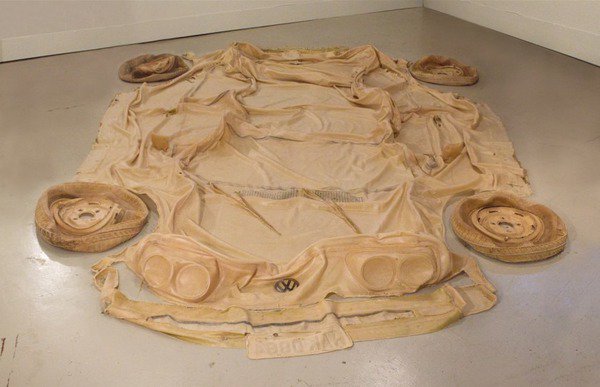Antoni Muntadas / Clarissa Tossin
dal 2/7/2014 al 1/8/2014
Segnalato da
2/7/2014
Antoni Muntadas / Clarissa Tossin
Galeria Luisa Strina, Sao Paulo
In "...Baixa a Bola!" Muntadas investigates topics such as mass events, control, spectacle, violence, sport and football - themes explored by the artist since the late 1970s. Tossin works across video, sculpture, and performance to reflect on the ways the built environment shapes us as subjects.

Antoni Muntadas
...Baixa a Bola!
Galeria Luisa Strina is pleased to present …Baixa A Bola! the seventh solo exhibition by multimedia artist Antoni Muntadas with the gallery. The show takes its name from a football move (to play low) that turned into a popular expression in Brazil, meaning “take it easy” or “don’t take yourself too seriously”. …Baixa a Bola! will investigate topics such as mass events, control, spectacle, violence, sport and football – themes explored by the artist since the late 1970s. This will be an apt and timely subject matter coinciding with the 2014 World Cup in Brazil.
The exhibition will feature a selection of images and video projections from the 1990s and 2000s, as well as recent unseen printed wall works using archival material such as newspaper headlines and internet images from Brazil and abroad.
Barcelona-born but a longtime New Yorker, Muntadas is considered one of the early and significant practitioners of media and conceptual art. He figures among the first generation of artists exploring the social and political power of mass culture and mass media and works in diverse disciplines spanning photography, video, publications, the Internet, installations and urban interventions. The interaction between citizens and contemporary social and cultural systems are at the core of his research.
…Baixa A Bola! will build on Muntadas’s previous “Stadiums” – an ongoing project since 1989, exploring the stadium from the perspectives of architecture, audience and propaganda. The installations are tailored for the gallery space and the local context, using videos and sounds that denote how politics, security, order and control come together during mass events. The most recent Stadium installation was “Stadium XVIII” presented at the Pinacoteca de São Paulo in 2011.
Born in 1942 in Barcelona, Muntadas has lived and worked in New York since 1971. He started working with Luisa Strina in the late 1970s and is one of the oldest represented artists by the gallery. His work has been exhibited internationally, including the 51st Venice Biennale (Spanish Pavilion), Documenta VI and X in Kassel, and the Sao Paulo, Whitney, Lyon, Gwangju and Istanbul Biennales.
Solo exhibitions include The Museum of Modern Art in New York, the Berkeley Art Museum in California, the Musee d’Art Contemporain de Montreal, the Capc de Bordeaux, France, the Museo de Arte Moderna de Rio de Janeiro in Brazil, and the Museo Nacional Centro de Arte Reina Sofia in Madrid, among other institutions. Muntadas has a long-standing academic career, teaching in universities worldwide.
------
Clarissa Tossin
Transplantado
Galeria Luisa Strina is pleased to present Transplantado, by Brazil born and US resident Clarissa Tossin. The artist works across video, sculpture, performance, and installation to reflect on the ways the built environment shapes us as subjects. Having grown up in Brasília, Brazil’s modern planned capital, made her aware of the global circulation of modernity images as well as their effects on the national and international psychologies. More recently, she has engaged with spaces and intertwining aesthetics where transnational histories of Brazil and the United States remain imprinted.
Transplanted is a natural latex cast of a Volkswagen Brasilia car. The first model entirely designed and manufactured by Volkswagen in Brazil, and named after the city envisioned for the car (Brasília). A popular car, the Brasilia soon became a national design icon. The car used for the latex cast in Transplanted is the central piece in the installation Brasília, Cars, Pools and Other Modernities, which will be on view at the Hammer Museum’s Los Angeles Biennial, Made in L.A., from June 15 to September 7, 2014.
The skin-like imprint is evocative of mass production processes since casting mimics the idea of endless copies. Transplanted approximates industry and its abstracted processes to the individual body by anthropomorphizing a car. Moreover, the sculpture’s skin-like formal quality provokes considerations about the pursuit of cars as a third skin in consumer society.
The sculpture uses latex as an art material while also considering its cultural and historical background as an industry commodity within the context of Brazil. The titled, Transplanted, was inspired by a passage in Brazil’s latex history: Henry Wickham’s successful quest to smuggle seeds from the rubber tree, Hevea brasiliensis, from the area of Santarém, in Brazil to Kew Gardens in London from where seedlings were dispatched to Malaysia thus dooming the Amazonian rubber boom. The word “transplanted” also further emphasizes the sculptural transformation of a hard car-body into a soft, malleable, cast/imprint of it.
Clarissa Tossin has a BFA by Fundação Armando Álvares Penteado, São Paulo, Brazil and a MFA in Art by the California Institute of the Arts (CalArts), Valencia, CA
Recent solo shows include: Museum of Latin American Art (MOLAA), Project Room – Long Beach (2014); Brasília, Cars, Pools & Other Modernities, Artpace – San Antonio, TX; Blind Spot, Blaffer Art Museum – University of Houston, Houston, TX; Study for a Landscape, Sicardi Gallery, Project Room – Houston, TX (2013)
Recent group shows include: Liberdade em Movimento, Fundação Iberê Camargo, Porto Alegre, BR (curated by Jacopo Crivelli); Apollo TBD, Samuel Freeman , Los Angeles, CA; Dispositivos para um mundo (im)possível, Roesler Hotel, São Paulo, BR (curated by Luisa Duarte) Art@Tell, University of St. Gallen, Zwitzerland (curated by Thamar Ette) (2014)
Image: Clarissa Tossin, Transplantado (VW Brasilia), 2012, latex, 38 x 274 x 18cm
Rua Padre João Manuel 755
Cerqueira César 01411-001 São Paulo SP Brazil
Open Monday to Friday from 10am to 7pm
Saturdays from 10am to 5pm



